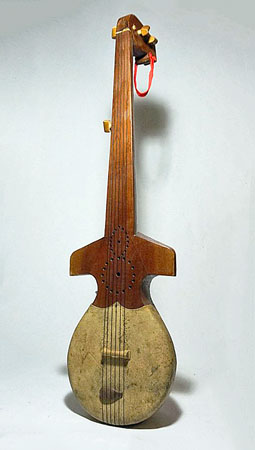
Owner: HWMC
Catalogue #: 2AS-CHLT-57
Lutes
Tajikistan ‘Pamiri Robab’ (Lute)
Tajikistan (Badakhshan Province)
Pamiri People
Wood, fiber, hide
Early-Mid 20th century
Length: 31 in; Width: 8.5 in; Depth: 5.5 in
Chordophones – Lutes
This robab is a long-neck lute from east Tajikistan. It is played in the Badakhshan province of Tajikistan, as part of the Pamiri (ethnic native group) musical tradition. The body, neck and peghead are made from a single hollowed-out piece of apricot wood. At the tope of the body are two extensions (wings) on both sides of the neck. Over the lower part of the body, under the accented wings is a thick animal skin attached with small nails. The lower rounded part of the body is covered with a thick skin. Sound holes are drilled into the area between the wings. The fretless neck is a bit tapering and has a straight turned-back (perpendicular) pegbox that supports five-friction pegs.
This Pamiri robab has six black fiber strings, one of which, is attached partway down the neck tuned with a peg, similar to the fifth string of the American banjo. The robab is primarily used as a done and rhythmic instrument for accompanying spoken or sung poetry.
